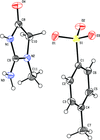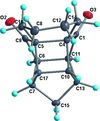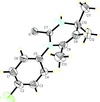issue contents
July 2016 issue

Cover illustration: In the cage compound hexacyclo[7.5.1.01,6.06,13.08,12.010,14]pentadecane-7,15-dione, an unusually long C-C cyclobutane bond length [1.607 (3) Å] is present. Only one very weak intermolecular hydrogen-bonding interaction is found in the crystal packing. See: Kotha, Bandi, Gunta & Gaddamedi [IUCrData (2016). 1, x161173].
metal-organic compounds
Download citation


Download citation


Open  access
access
 access
accessIn the title compound, the Ni2+ cation is coordinated by two terpyridine ligands with a slightly distorted NiN6 coordination polyhedron. It crystallizes as a hemihydrate with two perchlorate anions to compensate the charges.
CCDC reference: 1486868
Download citation


Download citation


Open  access
access
 access
accessThe ZnII atom in the title compound has a τ4 index of 0.85, indicative of a distorted tetrahedral coordination environment, defined by two N atoms of the heterocyclic ligand and two Cl atoms.
CCDC reference: 1486913
Download citation


Download citation


Open  access
access
 access
accessThe crystal structure of the dinuclear compound di-μ-bromido-bis[bromido(4,4′-dihydroxy-2,2′-bipyridine-κ2N,N′)copper(II)] consists of five-coordinate CuII atoms in square-pyramidal Br3N2 environments. The dimer exhibits π–π stacking interactions and hydrogen bonding between the hydroxy group and the terminal halogen atoms of adjacent molecules.
CCDC reference: 1487651
Download citation


Download citation


Open  access
access
 access
accessThree kinds of bridging ligands, 4,4′-oxydibenzoate, 4-(4-carboxyphenoxy)benzoate and 3-(pyridin-4-yl)-5-(pyridin-3-yl)-1H-1,2,4-triazole, link the CdII cations to form the title polymeric complex, [Cd2(C14H8O5)(C14H9O5)2(C12H9N5)2]n, in which each CdII cation is in a distorted N2O5 pentagonal–bipyramidal coordination geometry. The 4,4′-oxydibenzoate dianion has 2 symmetry, with the central O atom located on a twofold rotation axis.
CCDC reference: 1490863
Download citation


Download citation


Open  access
access
 access
accessIn the compound [Na2(C16H7Cl3N5O2)2(CH4O)4]·C4H10O·2CH4O, the central pyrazolo[3,4-d]pyrimidine system makes dihedral angles of 82.98 (7)° with the trichlorophenyl ring and 13.11 (15)° with the pyridine ring. The sodium ion has an octahedral environment, coordinated by four methanol molecules and two pyridine rings.
CCDC reference: 1490105
Download citation


Download citation


Open  access
access
 access
accessIn the title bis-chelated palladium complex, the metal exhibits a square-planar coordination geometry with the N,S-chelating ligands arranged in a trans configuration.
CCDC reference: 1492179
Download citation


Download citation


Open  access
access
 access
accessA solvated nickel hydrogen phthalate (Hpht) coordination complex with N,N′-(ethane-1,2-diyl)bis(isonicotinamide) (ebin) co-ligands, {[Ni(Hpht)2(ebin)2(H2O)2].6H2O}, was isolated and structurally characterized. Supramolecular layers form via O—H⋯O and O—H⋯N hydrogen bonding.
CCDC reference: 1494370
organic compounds
Download citation


Download citation


Open  access
access
 access
access3,4-Dimethoxybenzaldehyde (C9H10O3) is almost planar. The crystal contains no hydrogen bonds.
CCDC reference: 1486850
Download citation


Download citation


Open  access
access
 access
accessIn the title isoindole, the methoxyphenyl ring is oriented at an angle of 9.5 (1)° with respect to the thiazole ring. In the crystal, molecules are linked via C—H⋯O interactions, forming C(7) chains along [010].
CCDC reference: 1488161
Download citation


Download citation


Open  access
access
 access
accessCarboxylic acid inversion dimers occur in the crystal of 2-(4,6-dimethyl-1-benzofuran-3-yl)acetic acid.
CCDC reference: 1484420
Download citation


Download citation


Open  access
access
 access
accessIn ethyl 2-[(5Z)-5-(4-methoxybenzylidene)-2,4-dioxo-1,3-thiazolidin-3-yl]acetate, the dihedral angle between the benzene and heterocyclic rings is 1.49 (6)°.
CCDC reference: 1487873
Download citation


Download citation


Open  access
access
 access
accessIndazolyl derivatives are heterocyclic compounds with important pharmacological activities. Ethyl 2-(6-nitro-2H-indazol-2-yl)acetate is a new derivative.
CCDC reference: 1489667
Download citation


Download citation


Open  access
access
 access
accessThe crystal structure of 2-(3-benzoylthioureido)-3-phenylpropanoic acid features inversion-related pairs of O—H⋯O and N—H⋯S hydrogen bonds, which together generate [20 ] chains.
] chains.
CCDC reference: 1490858
Download citation


Download citation


Open  access
access
 access
accessIn the crystal of ethyl 1-benzyl-2-(3-chlorophenyl)-1H-benzimidazole-5-carboxylate, inversion dimers linked by pairs of C—H⋯O interactions generate  (22) loops.
(22) loops.
CCDC reference: 1431411
Download citation


Download citation


Open  access
access
 access
accessIn the cation of the salt 2-methylpyridinium 2-carboxy-6-nitrobenzoate, the pyridine ring is protonated at the N atom and the anion is deprotonated at one of the hydroxy O atoms. The crystal structure is stabilized by N—H⋯O, O—H⋯O and C—H⋯O hydrogen bonds, and also by a π–π interaction.
CCDC reference: 1491386
Download citation


Download citation


Open  access
access
 access
accessIn the 2-amino-4-methylpyridinium cation, the pyridine ring is protonated at the N atom and the 2-(3-methylphenyl)acetate anion is deprotonated at the hydroxy O atom. The molecular structure is stabilized by N—H⋯O hydrogen bonds and the crystal structure features N—H⋯O, C—H⋯O, C—H⋯π and π–π interactions.
CCDC reference: 1491153
Download citation


Download citation


Open  access
access
 access
accessThe title compound is a fungal-transformed metabolite of medroxyprogesterone comprised of one cyclohexanone ring, two cyclohexane rings and one cyclopentane ring fused together. The cyclohexanone ring has a half-chair conformation, while the cyclohexane rings possess chair conformations and the cyclopentane ring adopts an envelope conformation.
CCDC reference: 1489720
Download citation


Download citation


Open  access
access
 access
accessThe title salt consists of a 1H-benzo[d]imidazol-3-ium cation and a (Z)-carboxyprop-2-enoate anion. The crystal structure features N—H⋯O and C—H⋯O hydrogen bonds.
CCDC reference: 1488139
Download citation


Download citation


Open  access
access
 access
access(E)-1-(4-Hydroxybenzylidene)-4-methylthiosemicarbazide is derived from methylthiosemicarbazide and hydroxybenzylidene fragments with a trans configuration at the C=N bond. The structure is stabilized by intermolecular N—H⋯S, N—H⋯O and O—H⋯S hydrogen bonds that form two-dimensional chains along the a and b axes.
CCDC reference: 1488061
Download citation


Download citation


Open  access
access
 access
accessThe title isoindole crystallizes with two independent molecules (A and B) in the asymmetric unit whose geometrical features are similar. In the crystal, A molecules are linked via C—H⋯N hydrogen bonds which form chains along the c axis. C—H⋯O interactions link B molecules into dimers.
CCDC reference: 1491736
Download citation


Download citation


Open  access
access
 access
accessIn the title compound, a new indazole derivative, the indazole ring system makes a dihedral angle of 64.73 (12)° with the pyrrole ring. In the crystal, molecules are linked by C—H⋯π interactions, forming undulating sheets parallel to the ab plane.
CCDC reference: 1491842
Download citation


Download citation


Open  access
access
 access
access5,7,12,14-Tetrahydro-5,14:7,12-bis([1,2]benzeno)pentacene-6,13-diol, C34H22O2, used in the synthesis of polymers of intrinsic microporosity (PIM) membranes, recrystallizes from DMF, as a DMF solvate.
CCDC reference: 1492134
Download citation


Download citation


Open  access
access
 access
accessThe title imidazole derivative is T-shaped, with the 4-cyanobenzene and 4-fluorobenzyl rings inclined to the imidazole ring system by 32.93 (11) and 83.7 (1)°, respectively.
CCDC reference: 1431412
Download citation


Download citation


Open  access
access
 access
accessIn the title molecular salt, the cation is protonated at the N atom of the imidazole ring and the anion is deprotonated at the hydroxy O atom. In the crystal, the anion and cation are liked via two N—H⋯O hydrogen bonds, forming an  (8) ring motif.
(8) ring motif.
CCDC reference: 1491856
Download citation


Download citation


Open  access
access
 access
accessThe molecular and crystal structure of 2-[(5-amino-1,3,4-thiadiazol-2-yl)sulfanyl]-N-(4-chlorophenyl)acetamide is reported. The crystal structure is stabilized through intermolecular N—H⋯N and N—H⋯O hydrogen bonds.
CCDC reference: 1428528
Download citation


Download citation


Open  access
access
 access
accessIn the title imidazo[2,1-b][1,3,4]thiadiazole derivative, the trichlorobenzene and thiadiazol rings are inclined to one another by 29.26 (17)°. In the crystal, a series of N—H⋯O, N—H⋯N and C—H⋯O hydrogen bonds link the molecules to form slabs parallel to the bc plane.
CCDC reference: 1491987
Download citation


Download citation


Open  access
access
 access
accessIn the cation of the title molecular salt, the pyridine ring is protonated at the N atom and the anion is deprotonated at the hydroxy O atom. In the crystal, anions and cations are linked by N—H⋯O and C—H⋯O hydrogen bonds, forming slabs parallel to the ab plane.
CCDC reference: 1491857
Download citation


Download citation


Open  access
access
 access
accessThe title compound is almost planar (r.m.s. deviation = 0.038 Å) and an intramolecular N—H⋯O interaction closes an S(6) ring. In the crystal, aromatic π–π stacking interactions occur [inter-centroid distance = 3.65 (2) Å].
CCDC reference: 1493829
Download citation


Download citation


Open  access
access
 access
accessThe molecular and crystal structure of 5-(2,4-dichlorophenoxy)-3-methyl-1-phenyl-1H-pyrazole-4-carbaldehyde is reported. The crystal structure is stabilized through intermolecular hydrogen bonds and weak interactions.
CCDC reference: 1491572
Download citation


Download citation


Open  access
access
 access
accessIn the title molecule, the n-decyl chains in extended conformation form the interior of the bilayer structure while weak C—H⋯O interactions help to stabilize the exterior surfaces.
CCDC reference: 1494817
Download citation


Download citation


Open  access
access
 access
accessIn the title 1,8-naphthyridine derivative, the central fused three-ring oxadiazaborininonaphthyridine system is planar (r.m.s. deviation of 0.03 Å). The phenyl ring lies in the plane of this ring system, making a dihedral angle of 0.61 (14)°, and is inclined to the pyridine ring by 9.02 (19)°.
CCDC reference: 1492104
Download citation


Download citation


Open  access
access
 access
accessThe title benzamide derivative crystallized with one half-molecule in the asymmetric unit, the whole molecule being generated by inversion symmetry. The compound has a twisted conformation with the dihedral angle between the amide group and the benzene ring being 52.4 (2)°.
CCDC reference: 1495108
Download citation


Download citation


Open  access
access
 access
accessIn the title cage compound, an unusually long C—C cyclobutane bond length [1.607 (3) Å] is present. Only one very weak intermolecular hydrogen-bonding interaction is found in the crystal packing.
CCDC reference: 1014204
Download citation


Download citation


Open  access
access
 access
accessIn the title dibenzo[b,d]silole molecule, the butyl group displays an extended conformation, with a C—C—C—C torsion angle of 176.8 (2)°.
CCDC reference: 1493435
Download citation


Download citation


Open  access
access
 access
accessIn 1-(4-fluorophenyl)-4,4,6-trimethyltetrahydropyrimidine-2(1H)-thione, the dihydropyrimidine ring is in a flattened boat conformation with deviations of 0.135 (2) and 0.371 (2) Å for the flurophenyl-substituted N atom and the dimethyl-substituted C atom, respectively from the four other essentially planar atoms. In the crystal, pairs of molecules related by twofold rotation axes are linked by N—H⋯S hydrogen bonds forming dimers.
CCDC reference: 1495083
Download citation


Download citation


Open  access
access
 access
accessThe title compound, C18H17NO2, crystallized with two independent molecules (A and B) in the asymmetric unit. The dihedral angle between the naphthalene ring system and the benzene ring is 74.67 (10)° in molecule A and 78.81 (9)° in molecule B.
CCDC reference: 1494062
Download citation


Download citation


Open  access
access
 access
accessIn the title compound, the indole ring is inclined to the central pyrrole ring by 25.7 (2)°. The chlorobenzene ring and the bromobenzene rings subtend dihedral angles of 56.5 (2) and 53.4 (2)°, respectively, with the central pyrrole ring.
CCDC reference: 1495298
Download citation


Download citation


Open  access
access
 access
accessThe crystal structure of 4-chloro-1-[2-(2-chlorophenyl)ethyl)-2-nitrobenzene is reported. The crystal structure features C—H⋯O hydrogen bonds and π–π interactions.
CCDC reference: 1495647
Download citation


Download citation


Open  access
access
 access
accessIn the crystal, the title compound forms helical supramolecular chains running parallel to the b axis via weak C—H⋯O hydrogen bonds.
CCDC reference: 1494818


 journal menu
journal menu


















































![[publCIF]](/logos/authorchecklist11.gif)





